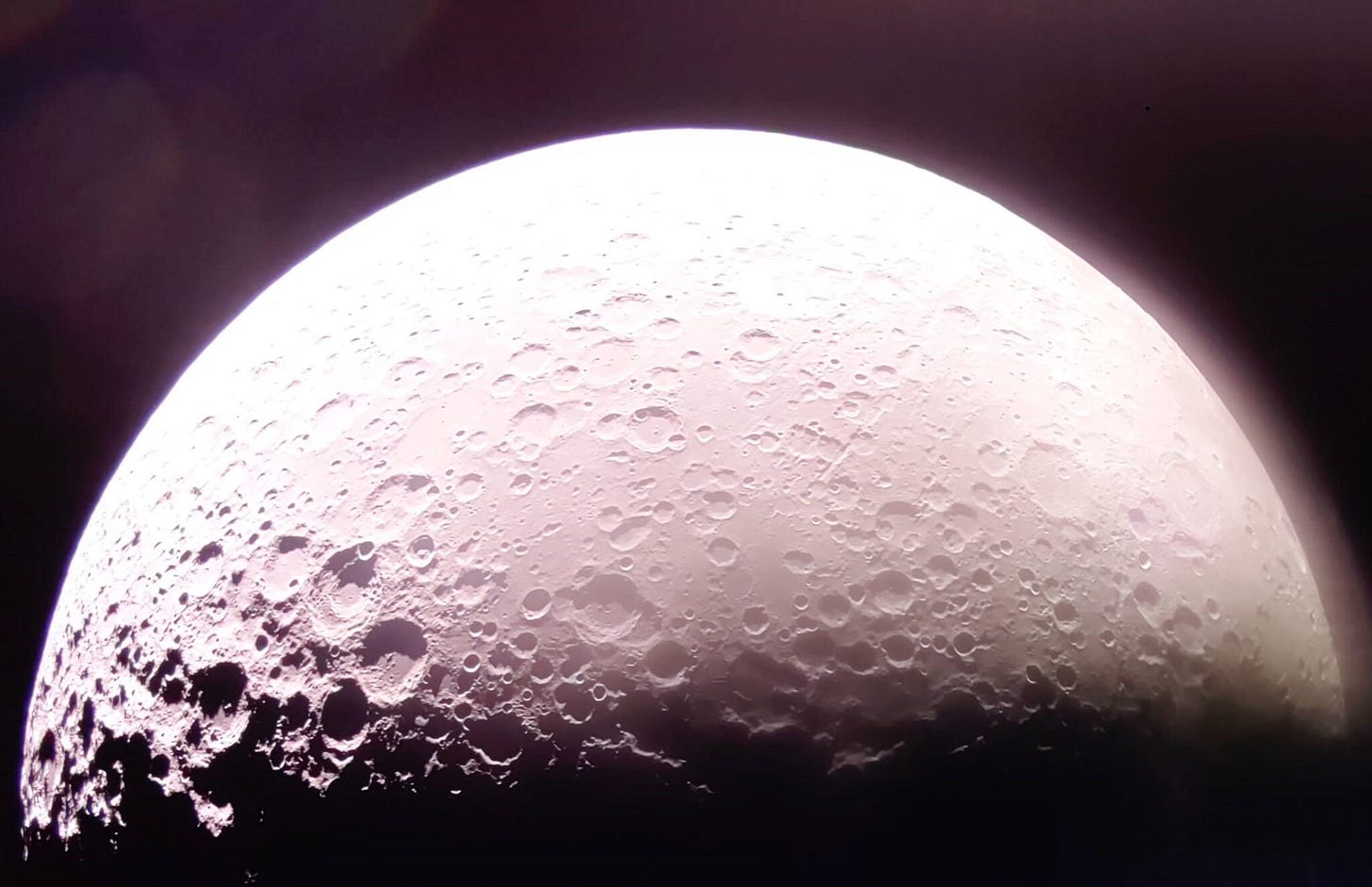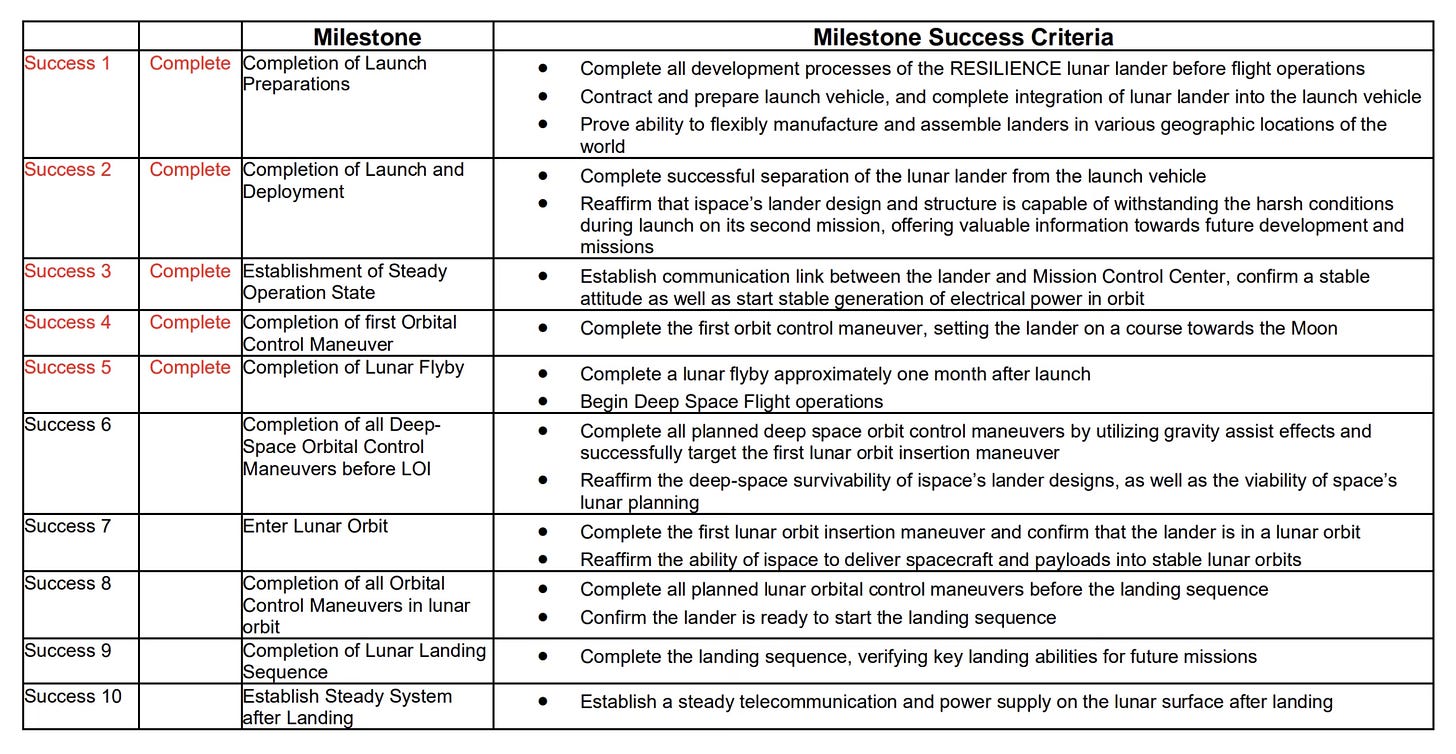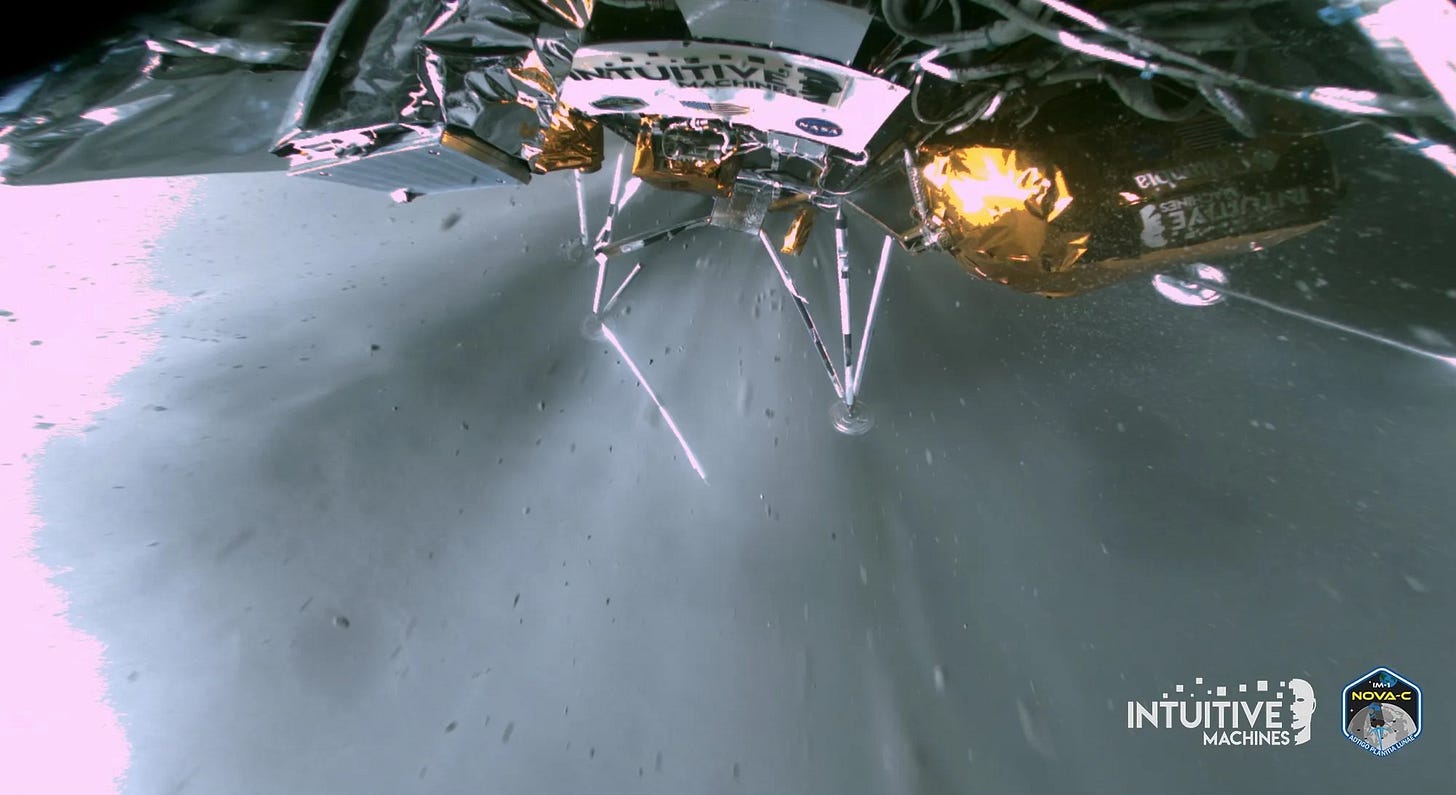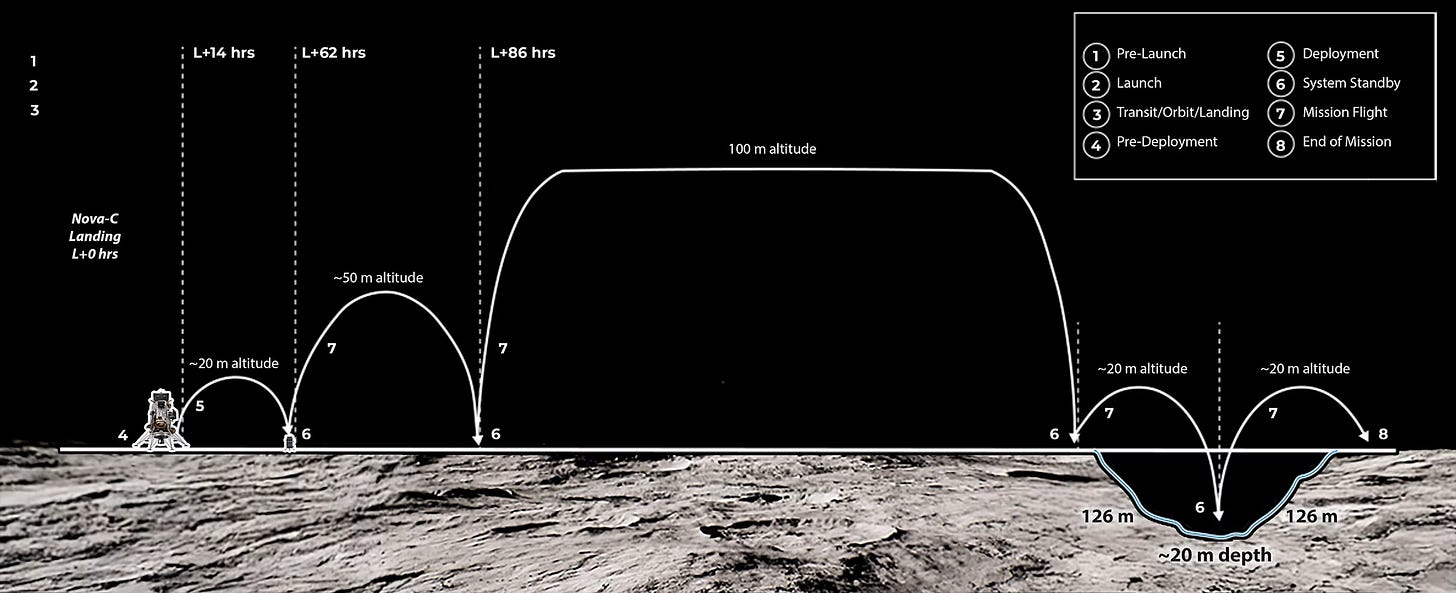The Moon is open for business.
What to expect from the 2025 lunar race?
After a record-breaking 2022—the year with the most lunar missions since Apollo—2025 is set to be another busy year for lunar exploration.

Today's lunar race is nothing like the one in the 1960s between the U.S. and the Soviet Union. Back then, the goal was to become the first nation to plant a flag on the Moon. Now, the focus is on landing safely and reliably—first with payloads, and by 2030, with humans through NASA’s Artemis missions. In the past, only government space agencies sent missions to the Moon. Today, space agencies and private companies, including publicly traded ones, are working together to deliver payloads to the lunar surface.
In 2025, a total of six lunar missions are planned, with two already on their way to the Moon:
RESILIENCE/M2 (ispace 🇯🇵) - January 15 2025 (Lunar Lander and Rover)
Blue Ghost 1 (Firefly Aerospace 🇺🇸) - January 15 2025 (Lunar Lander)
Athena/IM-2 (Intuitive Machines LUNR 0.00%↑ ) 🇺🇸 - February 26 2025 (Lunar Lander)
Lunar Trailblazer 🇺🇸 - February 26 2025 (Lunar Orbiter)
Griffin Mission 1 🇺🇸 - Fall 2025 (Lunar Lander)
Lunar Pathfinder 🇪🇺 - 2025 (Lunar Orbiter)
IM-3 (Intuitive Machines LUNR 0.00%↑) 🇺🇸 - 2025 - Lunar Lander and Rovers
You can find the full Lunar Exploration Timeline here.
Two Publicly Traded Companies to Attempt Lunar Landings
Intuitive Machines (LUNR 0.00%↑) is set to land on the Moon twice this year, delivering scientific instruments to the surface.
Nearly a year ago, on February 25, 2024, Intuitive Machines successfully landed its Nova-C lunar lander on the Moon as part of the IM-1 mission. However, the lander tipped over after touchdown, preventing some mission objectives from being fully accomplished.
From liftoff to landing, the company’s stock surged ~200%. But following the successful touchdown, many investors “sold the news” to realize their quick gain, pushing the stock into a downtrend over the next few months. The bearish trend reversed when NASA awarded Intuitive Machines an Indefinite Delivery, Indefinite Quantity (IDIQ) contract to deploy lunar relay satellites and provide communication and navigation services—a contract with a maximum potential value of up to $4.82 billion.
Since then, the stock has been on an upward trend. The Federal Procurement Data System confirms that NASA has likely already started payments to Intuitive Machines as part of the $4.82B IDIQ contract.
With IM-2 approaching liftoff, the big question is how market sentiment will react this time. Will the stock follow the same pattern as last year, with a surge leading up to the landing and a sell-off afterward? Or will investors hold their positions this time, betting on the company’s long-term potential? Regardless of the mission’s outcome, it’s almost impossible to predict where the stock will settle. One thing is certain: the company will get a lot attention from the media in the coming days.
More details on the IM-2 mission are further down in this post.
ispace Inc. (TYO: 9348), a publicly traded Japanese space company, is preparing for its second attempt at a lunar landing. In 2023, the company made history by attempting the first-ever Japanese private lunar landing. Unfortunately, the mission ended with a failure. During descent, an issue with the lander’s altitude measurement system led to a critical miscalculation. The system estimated the lander was safely on the surface when, in reality, it was still about 5 km above the Moon. As the lander continued its slow descent, it eventually ran out of fuel, leading to an uncontrolled free-fall to the lunar surface.
Two Lunar Landers Launched Simultaneously
The year kicked off with the simultaneous launch of two lunar landers aboard a SpaceX Falcon 9 rocket on January 15 at 1:11 a.m. EST. These landers, built by companies from different countries, were deployed into orbit: Blue Ghost 1 from Firefly Aerospace (Cedar Park, Texas) and RESILIENCE from the publicly traded Japanese company ispace.
Both missions share similar objectives: delivering payloads to the lunar surface.
ispace’s lunar missions are part of HAKUTO-R, an initiative to transport government and private payloads to the Moon. The company says the name “HAKUTO” means “white rabbit” in Japanese, inspired by a folklore tale about a white rabbit living on the Moon.
Firefly’s lunar missions, on the other hand, are part of NASA's Commercial Lunar Payload Services (CLPS) initiative. NASA partners with U.S. companies to send science and technology to the lunar surface. CLPS contracts operate under an Indefinite Delivery, Indefinite Quantity (IDIQ) contract structure, with a maximum potential value of $2.6 billion through 2028. Another CLPS provider, Intuitive Machines (LUNR 0.00%↑ ), is next in line to launch its lunar lander later this month.
In total, 14 companies are part of NASA’s CLPS initiative. Some have already received task orders, while others remain eligible to bid for future lunar delivery contracts:
Astrobotic (awarded two task orders in 2018)
Ceres Robotics (selected in 2019)
Draper (awarded one task order in 2022)
Intuitive Machines LUNR 0.00%↑ (selected in 2018 and awarded four task orders)
Masten Space Systems (selected in 2018)Orbit Beyond (selected in 2018)
SpaceX (selected in 2019)
Blue Origin (selected in 2019)
Deep Space Systems (selected in 2018)
Firefly Aerospace (selected in 2018 and awarded four task orders)
Lockheed Martin Space LMT 0.00%↑ (selected in 2018)
Moon Express (selected in 2018)
Sierra Nevada Corporation (selected in 2019)
Tyvak Nano-Satellite Systems (selected in 2019)
Masten Space Systems filed for Chapter 11 in 2022 and was acquired by Astrobotic Technology in September 2022.
Unfortunately, bankruptcy is common in the space industry… something worth diving into in a future post! For now, let’s turn our attention back to Blue Ghost and RESILIENCE…
Firefly Aerospace Blue Ghost Mission 1
This marks Firefly's first attempt at landing on the lunar surface.
As part of NASA’s CLPS initiative, Blue Ghost will deliver 10 science and technology instruments to the Moon:
LISTER (Lunar Instrumentation for Subsurface Thermal Exploration with Rapidity) — Developed by Honeybee Robotics (a Blue Origin company), this instrument will measure heat flow from the lunar subsurface.
Lunar PlanetVac (LPV) — Another Honeybee Robotics system, LPV is a fast, low-cost, and lightweight tool designed to collect and sort lunar regolith.
Next Generation Lunar Retroreflector (NGLR) — Developed at the University of Maryland, this device will reflect short laser pulses to measure the precise Earth-Moon distance.
Regolith Adherence Characterization (RAC) — Created by Aegis Aerospace, RAC will study how lunar dust sticks to different materials throughout a full lunar day.
Radiation Tolerant Computer (RadPC) — Built by Montana State University, RadPC is designed to withstand space radiation by recovering from faults caused by ionizing radiation.
Electrodynamic Dust Shield (EDS) — A NASA-developed system that uses electric fields to prevent dust accumulation on surfaces.
Lunar Environment Heliospheric X-ray Imager (LEXI) — A NASA instrument, developed with Boston University and Johns Hopkins University, designed to capture X-ray images of solar wind interactions with Earth’s magnetic field to study geomagnetic storms.
Lunar Magnetotelluric Sounder (LMS) — Developed by Southwest Research Institute, LMS will analyze the internal structure of the Moon by measuring electric and magnetic fields.
Lunar GNSS Receiver Experiment (LuGRE) — A joint project by NASA and the Italian Space Agency, LuGRE will track GPS and Galileo satellite signals throughout the journey and during a full lunar day.
Stereo Camera for Lunar Plume-Surface Studies (SCALPSS) — A NASA experiment using stereo imaging to analyze how a lander’s rocket plume affects lunar regolith during descent.
You can learn more about Blue Ghost payloads here.
So far, Blue Ghost has been on its way to the Moon with no reported issues.
After deployment, Firefly's mission team quickly acquired the lander’s signal and confirmed its health through system checkouts. On the same day, Blue Ghost captured its first image from space. Following the launch, the team calibrated the payloads in preparation for surface operations.
After orbiting Earth for a few weeks, on February 8, Blue Ghost successfully performed a Trans-Lunar Injection (TLI) burn, escaping Earth’s gravity and beginning its four-day transit to the Moon. The lander will then spend approximately 16 days in lunar orbit before its final descent to the lunar surface.

Blue Ghost is expected to land on the lunar surface on March 2, 2025.
You can find the latest updates on Firefly’s mission here.
ispace HAKUTO-R M2 mission
The journey to the Moon for ispace’s RESILIENCE lander and its payloads has also been progressing smoothly. As of February 19, 2025, the company has set 10 mission milestones, with five already successfully completed.
Shortly after Blue Ghost 1 separated from Falcon 9’s second stage, RESILIENCE followed. ispace’s mission teams quickly established communication between the lander and their Mission Control Center.
After a successful in-orbit maneuver, the lander was placed on a trajectory to perform a lunar flyby.
RESILIENCE carries multiple payloads, including scientific instruments, technology demonstrations and symbols:
Water Electrolyzer Equipment — Developed by Takasago Thermal Engineering Co., this system will support water electrolysis experiments on the Moon.
Food Production Experiment — A self-contained module from Euglena Co., designed to test sustainable food production in a lunar environment.
Deep Space Radiation Probe — Created by the National Central University, this probe will measure radiation levels in deep space.
Commemorative Alloy Plate — Developed by the Bandai Namco Research Institute, Inc., this plate is modeled after the “Charter of the Universal Century” from Mobile Suit Gundam UC.
TENACIOUS Micro Rover — Built in-house by ispace, this small lunar rover will explore the landing site, collect lunar regolith, and relay data back to the lander. It features a forward-mounted HD camera and a shovel for sample collection.
Moonhouse — A model house by Swedish artist Mikael Genberg, mounted on the TENACIOUS rover, symbolizing future human habitation on the Moon.

On Valentine’s Day, RESILIENCE made history as the first Japanese commercial lunar lander to complete a lunar flyby, passing within 8,400 kilometers of the Moon’s surface.
While Blue Ghost is set to land on March 2, 2025, we’ll have to wait a little longer for RESILIENCE to attempt its landing. ispace plans for the lander to begin its descent in early May.
After its flyby, RESILIENCE is now on a deep space trajectory, where it will perform a series of orbital maneuvers to guide it back toward the Moon.
By subscribing to this newsletter, you are supporting the creation of insightful, high-quality content focused on the space industry.
As a paid subscriber, you will gain access to additional exclusive benefits:
Exclusive deep dives into space stocks and company developments
Full insights into quarterly space stock reports
Access to a subscriber-only chat for in-depth discussions and transparent updates on my portfolio moves
Upgrade today to get the most out of the space industry!
A Public Texan Company to Attempt a Moon Landing
In the coming days, Intuitive Machines (LUNR 0.00%↑) will be the next company to attempt a lunar landing.
Throwback to last year’s lunar Barbenheimer
Last year, two companies, Astrobotic and Intuitive Machines, were in a race to become the first U.S. company to land on the Moon since Apollo 17 in 1972.
As part of NASA’s CLPS initiative, Astrobotic launched their Peregrine lunar lander on January 8, aboard the brand new Vulcan rocket from United Launch Alliance (ULA). Unfortunately, a few hours after launch, Astrobotic reported a propulsion system issue that prevented Peregrine from achieving a stable sun-pointing orientation. The company decided to perform an unplanned maneuver to reorient the solar panels and later confirmed the vehicle was generating power again. However, teams discovered a propellant leak, and there wouldn’t be enough fuel to make it to the Moon. As a result, Astrobotic decided to guide Peregrine into a controlled re-entry into Earth's atmosphere, preventing it from contributing to space debris.
Astrobotic is now targeting fall 2025 for the launch of their medium-class lander, Griffin, which was set to carry NASA’s VIPER rover, designed to search the regolith for water ice, before the agency decided to discontinue the development of their rover. Intuitive Machines has expressed interest in taking it over, to deliver VIPER to the lunar surface with Nova-D, a larger lander.
I’m thinking about diving into NASA’s VIPER project for a future post... Stay tuned!
Following Astrobotic, Intuitive Machines was the next U.S. company to attempt a lunar landing with its IM-1 mission. The Nova-C lander, named Odysseus for the mission, was originally set to launch on February 13, but was delayed to February 15 due to an issue with propellant loading. On February 15, Odysseus lifted off aboard a Falcon 9 rocket. The second stage of the rocket successfully placed the lander on a trans-lunar injection (TLI) trajectory. Teams at Intuitive Machines then established communication with Odysseus and completed initial checkouts.
Nova-C is very unique because it uses liquid methane and liquid oxygen as propellants. This mission marked the first use of methalox propulsion beyond low Earth orbit (LEO).
After completing three scheduled trajectory correction burns, the lander successfully entered lunar orbit. Before landing, controllers uploaded a last-minute software patch to fix an issue with the lander’s altitude monitoring system.
Odysseus then began its landing sequence.
Shortly after landing, poor communications confirmed that the lander had touched down and was still alive. However, an analysis of the telemetry data later revealed that Odysseus was tilted at a 30-degree angle.
Despite tipping over after landing, Odysseus made history as the first U.S. vehicle to land on the Moon since Apollo 17 in 1972. It also marked the first-ever commercial lunar touchdown.
On January 28, Intuitive Machines announced the delivery of its NOVA-C lunar lander, nicknamed Athena, to Cape Canaveral. IM-2’s launch is scheduled within a four-day window opening no earlier than February 26, 2025.
IM-2 sets even more ambitious goals than its predecessor, IM-1. The primary mission, also known as the Polar Resources Ice Mining Experiment-1 (or simply PRIME-1), aims to search for water ice at the lunar south pole. The search for water on the Moon has become a major focus, as it will be essential for long-duration crewed missions. PRIME-1 will drill into the surface to extract regolith and understand what lies beneath the lunar surface. As part of IM-2, NASA will also send the Lunar Trailblazer, a secondary payload designed to map water on the lunar surface.
NASA Paid a Company $1 to Retrieve a Moon Sample
Aboard Athena, the private U.S. space company Lunar Outpost will be sending its first lunar rover, the Mobile Autonomous Prospecting Platform (MAPP). The rover will map the Moon's surface, capture stunning images, and even inspect regolith samples! On top of that, NASA contracted the company to collect lunar samples for the symbolic amount of $1!
In addition to PRIME-1, Athena will also carry commercial payloads:
Micro-Nova Hopper, a propulsive drone named Grace, honoring Grace Hopper, a pioneer in mathematics and programming who contributed to early computing.
Lunar Surface Communication System (LSCS) — Developed by Nokia Bell Labs, this payload will demonstrate 4G/LTE capabilities
MiniPIX TPX3 SPACE — Developed by the Czech company ADVACAM, this payload will monitor the radiation field on the Moon
The exact same cellular technology that powers billions of devices on Earth every day will soon be used on the Moon!
The Micro-Nova Hopper, which will also host Nokia LSCS, is expected to perform a total of five hops, using its thrusters to launch itself across the lunar surface. The hopper will look for hydrogen, to determine the presence of water ice.
The European Space Agency to Focus on Lunar Missions
The European Space Agency (ESA) is also looking to be more involved in these lunar missions.
“Lunar Pathfinder”, a lunar orbiter developed by Surrey Satellite Technology (SSTL) for ESA, is scheduled to launch next year aboard Firefly’s Blue Ghost 2 mission.
Once in orbit around the Moon, this spacecraft will become the world’s first dedicated lunar communications relay spacecraft.
Given that most Artemis missions will be conducted on the South Pole of the Moon, the lunar orbiter will be in a particular orbit such as it can cover that region effectively.
Additionally, the orbiter will carry two separate ESA experiments. One experiment aims to explore the feasibility of utilizing existing navigation satellites for lunar positioning. The other will monitor space weather to study radiation levels around the Moon.
Preparing for Humanity's Return to the Moon
All these missions to the Moon are preparing for a long-term and permanent return to the Moon. The International Space Station (ISS) is set to retire in the coming years, and NASA 🇺🇸, the Canadian Space Agency 🇨🇦, the European Space Agency 🇪🇺, Japan Aerospace Exploration Agency 🇯🇵 and Roscosmos 🇷🇺 have agreed to deorbit it in a controlled manner.
The next International Space Station won’t be around Earth; it will be around the Moon.
The first modules of the Lunar Gateway are going to be launched as soon as 2027.
The Moon is becoming an important place for business, playing an important role for the next steps in space exploration. Its proximity to Earth and resources, like water ice, make it ideal for future crewed missions.
By delivering new scientific instruments and technologies, upcoming missions will deepen our understanding of the Moon and pave the way for future crewed lunar missions.









This newsletter is going to the moon!